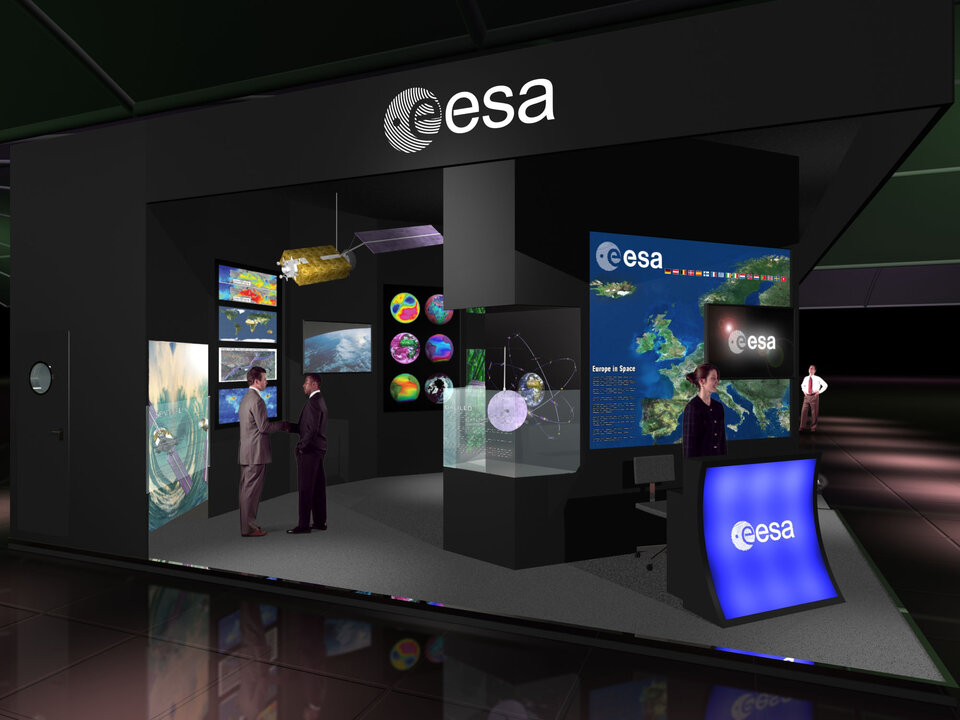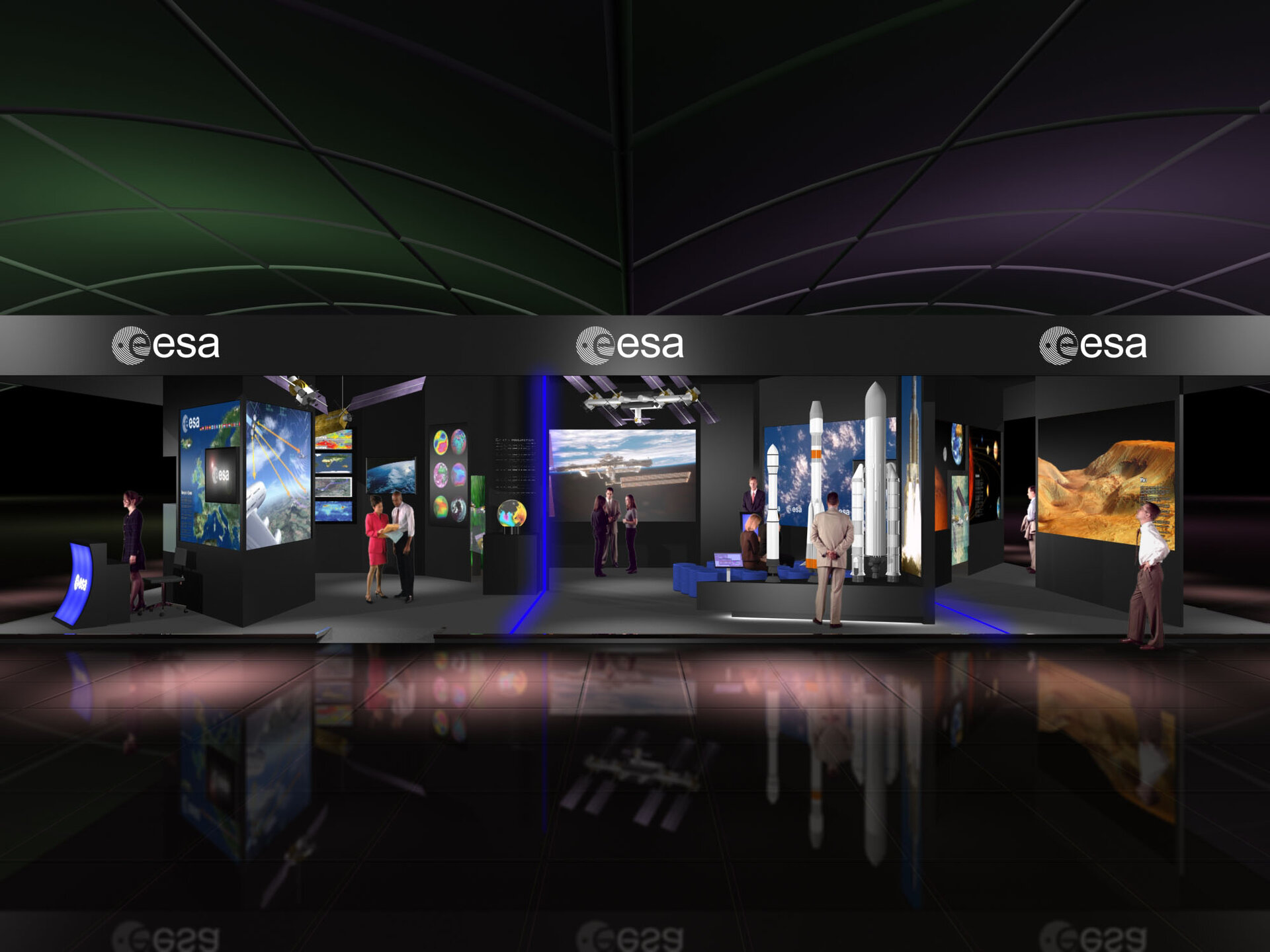ESA exhibition at IAC 2008, Glasgow, UK
The 59th International Astronautical Congress, IAC, will be held in Glasgow, Scotland, from 29 September to 3 October 2008 at the Scottish Exhibition and Conference Centre.
The IAC brings together space agencies, industry, academic researchers and students from all over the world. It is organised by the International Astronautical Federation (IAF) and its associates, the International Academy of Astronautics (IAA) and the International Institute of Space Law (IISL).This year the local organiser is the British Interplanetary Society (BIS).
The slogan of the IAC 2008 is “from imagination to reality”, a phrase particularly apt this year for ESA, which has seen the successful accomplishment of very important missions: the launch and attachment of the Columbus laboratory to the ISS, the successful docking of the Automated Transfer Vehicle ATV, the successful launch of GIOVE-B, Galileo In-Orbit validation Element .
“Our presence at IAC this year is really important” says Fernando Doblas, Head of ESA Communications. “In November, ministers responsible for space activities in ESA’s Member States and Canada will meet in The Hague to set the course of Europe’s space programmes over the years ahead. Space is a major source of inspiration, innovation, competitiveness and progress in our modern society. ESA’s presence at IAC aims at highlighting that Europe has a moment of opportunity in The Hague, a rendezvous with its future”.
The vast range of ESA activities can be seen at the conference exhibition inaugurated on Monday 29 by the HRH Duke of Gloucester.

In an area of 150 m2 ESA’s programmes are presented with space data and images, audiovisuals and models with a special focus on upcoming missions. “Our display”, explains Maria Menendez, Head of ESA exhibitions, “aims to inform visitors about European space programmes, and in particular underlines their impact to improve the quality of our life”.
ESA’s activities in the fast-moving world of telecommunications are presented with a special spotlight on Alphasat, a new multi-purpose platform for telecommunication satellites. Galileo, Europe’s own global navigation satellite system, is also showcased with the first four satellites of the in-orbit validation phase.
The area dedicated to our planet explains how Earth observation satellites have allowed Europe to gain a leading role in understanding weather, environmental and climate change. The public can learn more about Envisat, launched in 2002, the world's largest satellite for environmental monitoring; GOCE, the first of the Earth Explorer satellites, to be launched in 2008, and Sentinel-1, the first satellites to be launched for the EU-led Global Monitoring for Environment and Security initiative, Kopernikus.
The tour of the exhibit continues with a zone dedicated to Ariane 5, the launcher that guarantees Europe’s independent access to space; introduces Vega, ESA’s new small launcher, plus a special version of Russia’s Soyuz that will soon be launched from Europe’s Spaceport in French Guiana.

Following the successful docking of Columbus and the Automated Transfer Vehicle, ATV, to the International Space Station (ISS), visitors have the opportunity to see stunning photos of the ISS, the largest joint technology project in human history. Columbus and the ATV mark two crucial achievements for Europe: the know-how that we have acquired so far will be of tremendous importance in preparing for future spaceflight to the Moon and Mars.
The first mission in ESA’s exploration programme, ExoMars, will give new insight on the existence of life on the red planet. A scale-model of this rover on a Mars terrain is also displayed.

The public are also introduced to the latest images of our surrounding planets and moons: impressive canyons of the red planet as observed by Mars Express, the South Pole of Venus, a map of lunar craters and the first image of Titan. Once launched (in 2013), BepiColombo, an ESA-Japan mission to study Mercury, will give scientists a better understanding of the telluric planets.
The tour ends with Herschel and Planck, two future powerful satellites that will look at the “invisible Universe”. Their instruments will observe celestial objects at wavelengths never used, improving our knowledge on the origin and evolution of the Cosmos.
The exhibition will be open to the general public on Wednesday 1 and Thursday 2 October from 16:00 to 18:00 hours, and on Friday 3 October from 09:00 to 12:00 hours.
For further information, please contact:
Maria Menendez
Head of Exhibition Office
Communication and Knowledge Department
Tel.: + 33 1 5369 7167
e-mail: Maria.Menendez@esa.int
Wendy Slater
Exhibitions Officer
Communication and Knowledge Department
Tel.: + 33 1 5369 7418
e-mail: Wendy.Slater@esa.int
Annie Sorlin
Epsec, Exhibition Assistant
Communication and Knowledge Department
Tel.: + 33 1 5369 7590
e-mail: Annie.Sorlin@esa.int




